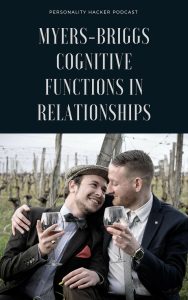Download Episode Here – right click link and select “Save Link As…”
In this episode Joel and Antonia talk about the Myers-Briggs cognitive functions and how they play a role in romantic relationships.
In this podcast you’ll find:
- Dichotomy in Relationships podcast
- Car Model
- Reference Guides for each cognitive function stack
- The Driver function is very unconscious. You do it automatically.
- If you are in a relationship with somebody who suppresses that driver function, it will cause conflict or depression.
- The driver puts you into flow. It energizes you and makes you feel good.
- It’s not good to be in a situation where that function isn’t being allowed expression.
- Get very clear on your dominant process, and your spouse’s, then have a conversation around it so you can both be aware of each other’s needs.
- Determine if you are leading with a learning process or a decision-making process.
- If your Driver is an iNtuitive or Sensing function, you lead with a learning process (referred to as Perceiving process in the podcast).
- If your driver is a Feeling or Thinking function, you lead with a decision making process.
- If one partner leads with a learning process and the other leads with a decision-making process, it can create conflict.
- People who lead with a learning process tend to hesitate before they make decisions. They want more info before they make a decision.
- Someone who leads with a decision-making process is going to come across way more decisive and live their lives in the realm of should statements.
- Two people driving with judging functions can create friction because each is certain how things should be.
- Two people who lead with learning process can take a long time to make a decision.
- A female who leads with a decision-making process and ends up in a relationship with a man who leads with a learning process may feel like she has to make all the decisions. She may feel like she can’t rest into him because he is so slow to make decisions.
- The Copilot is our auxiliary cognitive function. Our growth state. It’s important we work on this process and use it.
- The Copilot is a more conscious part of our personality, and we can have a tendency to bypass it if we want to stay in a comfortable place.
- When we first start working on our copilot, it could be messy. Stay the course!
- Get clear on the needs of your copilot. If you are an extravert and your copilot is introverted, you have to have introverted time.
- Some people just need to know what is going on with you. Be clear about your needs, so the other person doesn’t misunderstand your actions.
- The Tertiary cognitive function (10 yr old) will be the same attitude as the driver. If your driver is introverted, this process will be introverted. It is a comfortable place for us.
- This function is best when used in times of play. Don’t let it run the show. Let it play, like a 10 yr old.
- When we ignore the copilot and stay in the attitude of the driver and tertiary process, it isn’t a good place for a person to be. We call it a loop.
- Figure out how you loop and discuss it openly so each can identify when it is happening.
- Why are you in the loop? What do you need to get back into your copilot?
- A lot of conflicts come from both people being in this 10 yr old process.
- Out of conflict comes intimacy.
- You can build understanding and intimacy through the conflict if you have the awareness to understand what is going on.
- If someone is getting stuck in the 10 yr old and it is a learning process, it can come across as avoidance. Either avoiding info or seeking distraction.
- If someone is getting stuck in 10 yr old and it is a judging or decision-making process it can show up as being resolute and insistent it is right.
- Te/Fe will try to push the outer world. Ti/Fi can look like you are sticking your flag in the ground and refusing to be budged.
- You might be fighting two different games if your spouse is one way and you are the other.
- If one can be aware enough to get out of the 10 yr old, they can help the situation by pulling the other person out of their 10 yr old.
- It’s not about winning or losing. It’s about building intimacy.
- The 10 yr old is the one that you are going to notice coming up more than anything else.
- The inferior process, 3 yr old, has the maturity of a 3 yr old.
- It is not conscious for most people. It feels icky sometimes.
- If you put your mate in a situation where their 3 yr old is exposed and hurt it will be interpreted as a betrayal.
- How does your 3 yr old show up and what would be a massive betrayal for you? What about your spouses 3 yr old. What would be a betrayal of them?
- Look at the car models for each personality side by side.
- See how they compare and contrast.
- What strengths do you share?
- What weaknesses do you share?
- How can compensate for each other’s blind spots?
- Create language and framework around your personalities so you can speak to each other’s strengths and weaknesses.
- Use this knowledge to increase understanding and open conversation.
- Don’t use this as a weapon.
- Use it as a means to improve communication and connection.
- Just having the language solves the majority of conflict.
To subscribe to the podcast, please use the links below:
Subscribe with iTunes
Non iTunes Link
Download The Android App
Subscribe on Soundcloud
Subscribe with Stitcher
Subscribe on Google Play
If you like the podcast and want to help us out in return, please leave an honest rating and review on iTunes by clicking here. It will help the show and its ranking in iTunes immensely! We would be eternally grateful!
Want to learn more?
Discover Your Personal Genius
We want to hear from you. Leave your comments below…



Share:
Podcast - Episode 0159 - Myers-Briggs Dichotomies In Relationships
Podcast - Episode 0161 - Systems Thinking In Relationships
19 comments
Fe is Harmony, though (ENFP, say), and Fi is Authenticity (INFP,say), as I understand it, so the Fi would be more likely to be sad because sad rather than not be sad because other people’s wellbeing over-rode honouring the authentic feeling. To me, you have them around the wrong way here, Patrick.
I kind of think you’d want to cuddle your 3 yr old! I’m also an INFP, and find some time in my life to use Te in fun and easy ways — drawing charts and diagrams with plans I’d like to do, playing video games that use it., etc.. I think that helps me from being blind in that area.
My friend who is INFJ really likes eating a little dessert now and then and completely giving over to that sensation. She also got into a Bollywood dance club that she and her friends did for fun.
When I’m working a job that requires me to plan or be efficient, I think I use Ne more than Te. I lead with finding ways that make sense to me, even if they’re new or less-used, and get feedback from other people about the strengths and weaknesses of my method(s), or iterations. I’ve heard other Te users say things like “I think about what needs to be done, what is or could be in the way, and sort through the fastest ways to accomplish that thing, all in a split second.” I don’t feel like I’m that good at it. But I’ve often been able to tell that Te user — “but have you ever thought about doing it this way” and providing them with new information that sometimes improves that process.
Hi Joel and Antonia!
I’m a first time commenter but long time listener to your podcast (which I found ages ago by searching ‘INFP’ on Podcast Addict). For the past few months I’ve been exploring, traveling in New Zealand and listening to many of your podcasts, and loving it. There’s a theme I’ve seen running in a few of them that I’ve ventured to this website to ask about.
Many times you and Antonia have talked about Fi or Harmony relating to “emotional Aikido,” and specifically in this podcast, the tendency of, what seems to me like, the Fi creating positive emotions and trying to get other people to feel them too. Antonia has talked about her personal experience being on the receiving end of that, and even being misled by that.
This has resonated with me, and my relationships. My partner leads with Fe as an ENFJ, and she has said things to me like, “you’re very quick to go to a positive place; sometimes I need the space to feel [angry] or [sad]…” and I’ve learned to add “giving space” to what I look for in how somebody else is feeling and what they need.
Have you and Antonia riffed on healthy interactions between Fi and Fe, how they show up in different types of work and personal relationships, and how to aim for healthy interactions?
Thanks for all the food for thought,
Patrick
I have really enjoyed the last two podcasts. I am an INTP who is becoming close with an INFP. I understand thatour auxiliary and tertiary functions are the same (Ne and Si ) and that we both lead with an introverted judging function (Ti and Fi). I have seen very little online about the INTP-INFP relationship. I know that I have Fi as a role function in my 8th slot, which I believe ( based on my reading in socionics) I can improve to a limited degree, while INFP’s have Ti as their 8th function and they can supposedly improve to a degree. I find my time with this INFP to be very intellectually stimulating as well as emotionally uplifting. They seem to be opening new (Fi) worlds to me in myself and in the arts that I did not know existed. They have said similar things to me in relation to new Ti concepts and abstract worlds they are now experiencing. I was wondering about possible difficulties and possible growth within such a relationship. Thank you!
I need help with this one. I’m INTP and my hubby is ISFJ. That means our stacks are Ti, Ne, Si, Fe (me) and Si, Fe, Ti, Ne (hubby).
Our 10 year old functions are each other’s primary/driver functions. It’s super easy to let each other loop. And, when you had a guest on talking about parenting your 10 year old with your driver, that means I am trying to use my hubby’s primary and his strength feels like parenting to me.
In addition, where we each need to grow is where the other is most fragile. So mucking around with our auxiliary/passenger function almost inevitably feels harmful to the other. This is especially true of me to him. He’s not eager to work on Fe being a super strong introvert. He cares for people but only those closest to him.
So I’m not sure how to get unstuck. If I can be more clear, please let me know.